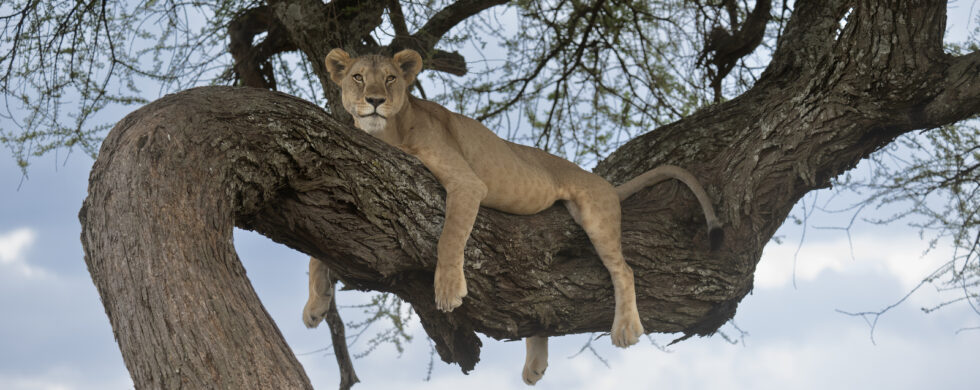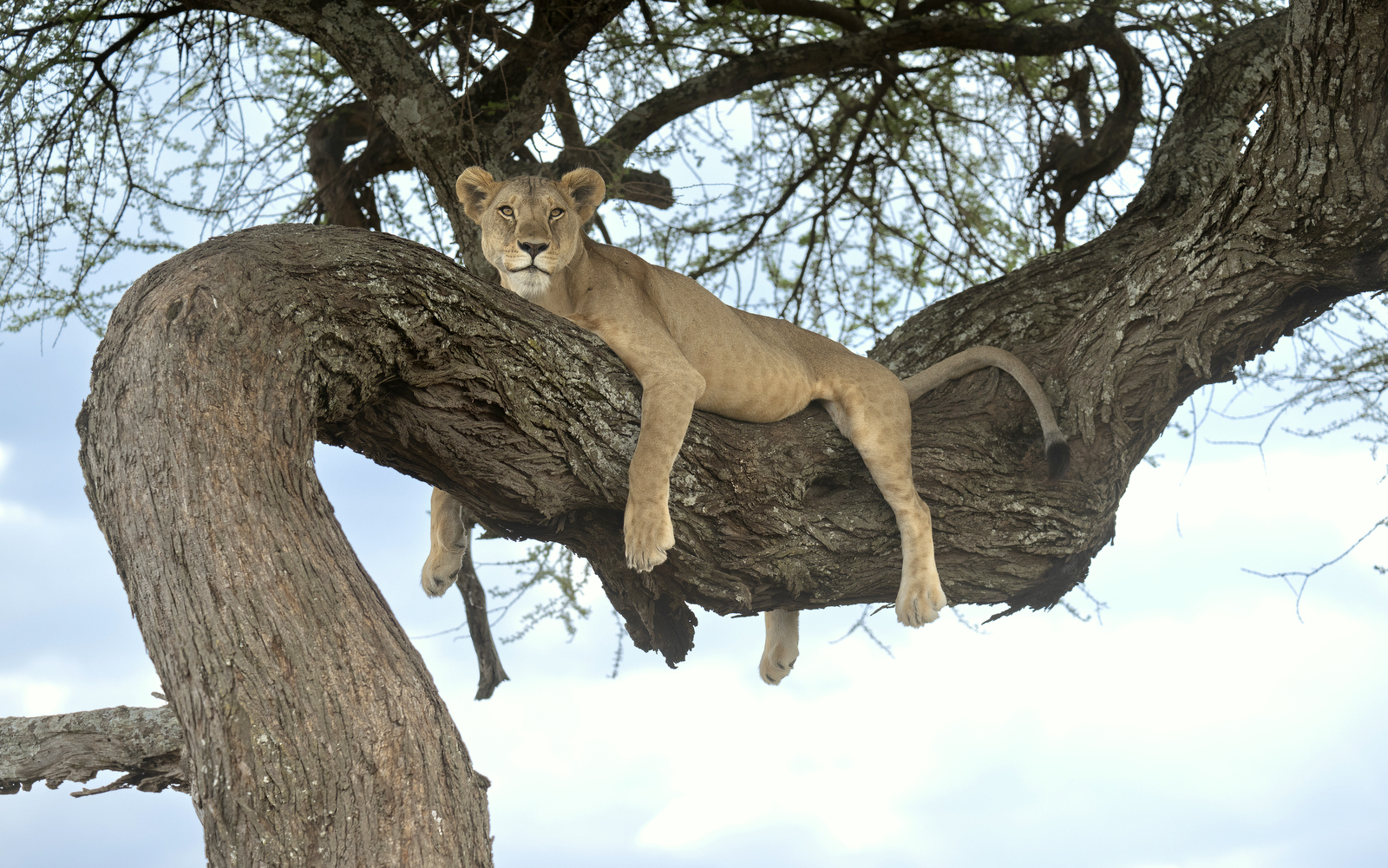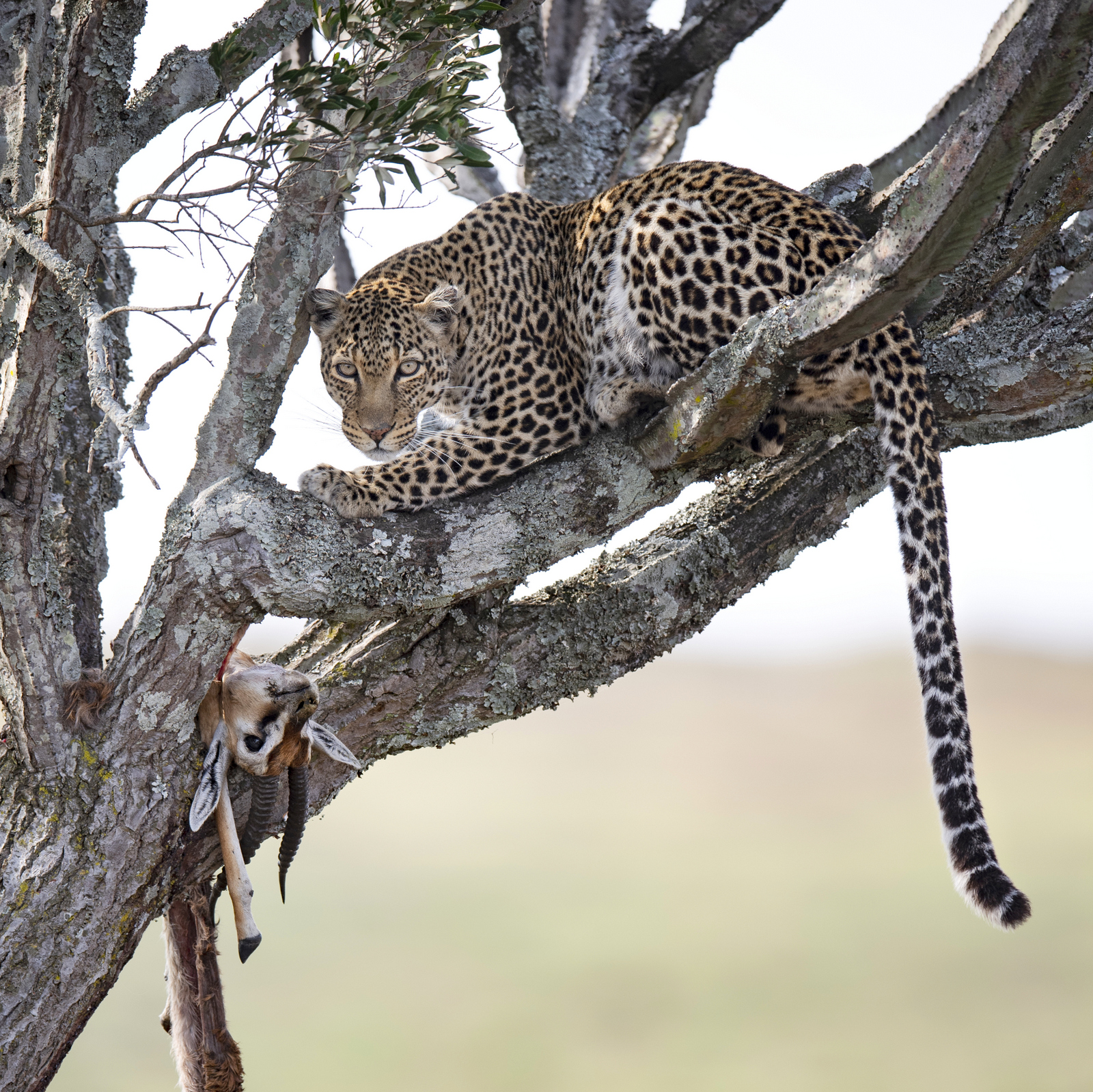
31
2024Lion Tree?
Shot of the Month – August 2024
When on safari my head is always on a swivel as we drive across the savannah. I peer left and right as my eyes scan the bushes and grasses for lions and cheetahs. When near trees I stick my head out the window, strain my neck, and squint my eyes to look up into the canopy in search of a leopard amongst the limbs and shadows. Imagine my surprise on this day in the Serengeti when I looked up and saw….a lion??! What is this lion doing relaxing up on this branch, rather far from terra firma?
Leopards take refuge in trees out of necessity – they live and hunt alone and cannot defend their meals against larger predators like lions and hyenas. Leopards evolved over millennia to be natural tree climbers so they can cache their meals high up in trees to be out of the reach of their thieving competitors.
A leopard with its kill in a tree:
Lions have no such need — they are the largest predators in their habitats and live in prides with 3 to 40 members (average size is 15) allowing them to defend their meals with ease.
And while leopards are perfectly built to climb trees, lions are not. Leopards are relatively light (ranging from about 50 to 160 pounds) and their shoulder blades are proportionally bigger, flatter, and more concave than a lion’s. Lions are built with enormously powerful forequarters and a very stiff back which is useful for wrestling heavyweight prey, such as buffalo to the ground. However, the lion’s powerful build reduces agility and vertical leaping ability, making tree climbing more difficult. Male lions can weigh 400 pounds so jumping out of a tree presents a real risk of dislocating a limb when landing with a thud back on earth.
There are currently about 21 countries with lions and the fact is that the vast majority of said lions never climb a tree. But, lions can learn to become tree climbers when the conditions are juuust right. For example, the lions in Queen Elizabeth National Park in Uganda are famous for their tree-climbing ways. Why there? Scientists note that the prides in this park tend to be smaller and share the habitat with large herds of buffaloes and elephants. Scampering up the local tree is a good escape plan when faced with a stampede of buffaloes. (See the Queen Elizabeth NP lions here.)
Lake Manyara National Park in Tanzania is another location well known for its arboreal-minded lions. Scientists noted that a very heavy rainfall in 1963 created a plague of Stomoxys biting flies and drove the resident lions up trees and down warthog burrows to escape the insects that caused open wounds and deadly infections. Lions have been seen climbing trees in this park ever since.
Tree-climbing lions have also been spotted in the Tarangire and Serengeti National Parks in Tanzania. More recently a lion pride in Kruger National Park in South Africa has been observed climbing trees.
So while seeing a lion in a tree is not common, it also is not unheard of. This behavior is usually based on unique circumstances and local conditions. Lions seem to climb trees to:
- Avoid insects
- Avoid heat (they can find a nice breeze a bit higher off the ground)
- Look for prey
- Steal prey from leopards
Lions can only climb trees if their local habitats have trees that are “lion-friendly.” This means trees with strong, low branches that can support cats weighing anywhere from 250 to 400 pounds. For example, the African sycamore fig trees or umbrella acacia thorn trees often have horizontal branches not too far above the ground and tend to be lions’ preferred “jungle gym.”
Once a pride experiences the benefits of tree climbing they can take to it with enthusiasm. The behavior is then passed down from one generation to the next.
You get entire families — adults, youngsters, everyone — up trees. Generation after generation, it really has become a habit to go up in the trees. It just gets entrenched as a culture because it’s fun.”
Dr. Luke Hunter
Lions tend to be much better at climbing a tree than getting down. It can be painful (and hilarious) watching these massive beasts awkwardly trying to exit a tree – the dismount can quickly become a Mr. Bean sketch.
Here is a video with a good summary on how and why lions climb trees:
Here we see lions trying to get a leopard’s kill out of a tree: (You can see how the large male lion struggles at tree climbing)
And here is a crazy interaction between a lion and a leopard in a tree that shows why lions need to be careful to stay on limbs that can support their weight! (The action starts at 0:25 seconds)
Sooo, next time you go tree climbing in your local safari park, look up first to see what may be “lion” around on the branch above. (Really? You didn’t see that coming??)
Until next month……michael
Sources
Wild Cats 101: Why Do Lions Climb Trees?
Why Do Some Lions Climb Trees? A closer look at tree climbing lions
Facts About the Tree Climbing Lion of Tanzania
Why Don’t All Lions Climb Trees? (NY Times)
Nikon Z9, Nikkor Z 100-400 mm (@190mm), f/5, 1/320 sec, ISO 200, EV +0.667


